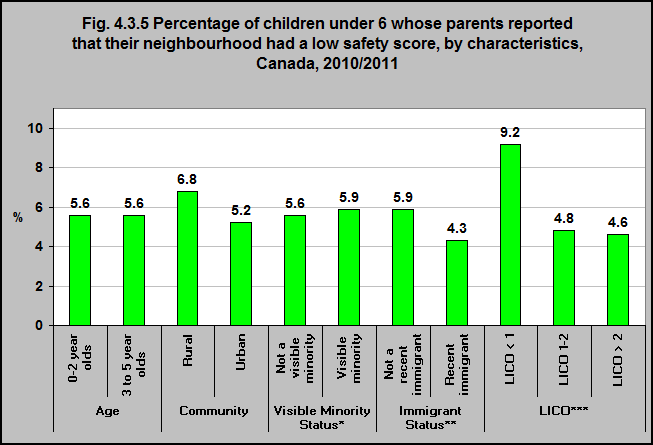Percentage of children under 6 whose parents reported that their neighbourhood had a low safety score, by characteristics, Canada, 2010/2011

Notes:
*Visible minority: self-identified as belonging to a racial or cultural group other than “White” (does not include Aboriginal).
**Recent immigrant: at least one parent reported that they had become a landed immigrant in Canada in the 10 years prior to the survey. Recent Immigrant- use with caution.
***LICO (low income cut off) data based on postal code information.Low and high scores were determined by the 10th/90th percentile cutpoints (as appropriate).
Source: CICH graphic created using data adapted from the Survey of Young Canadians 2010/2011, Statistics Canada – custom runs.
Children under 6 in rural communities were more likely to live in neighbourhoods that their parents felt had low levels of neighbourhood safety1 than were those living in urban areas.
Children who were not recent immigrants were more likely to live in neighbourhoods that their parents felt had low levels of neighbourhood safety than were recent immigrant children.
Children living in the lowest income group were more likely to live in neighbourhoods that their parents felt had low levels of neighbourhood safety than those in higher income groups.
1The neighbourhood safety scale can be used to measure the extent to which the PMK (person most knowledgeable) feels that there is a sense of safety in the neighbourhood. All questions about the neighbourhood were administered to the PMK or spouse/partner of the PMK. To identify low levels of neighbourhood safety, thresholds (or cutoff points) were established by taking the scale score that is closest to the 10th percentile based on Cycle 4 data (because the question was not asked in Cycle 3) for children in all provinces. The variable represents the proportion of children living in neighbourhoods with a lower sense of safety (as reported by the PMK) and those who do not.The Well-Being of Canada’s Young Children: Government of Canada Report 2011. Technical Notes
